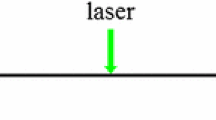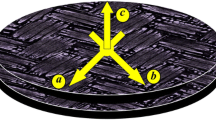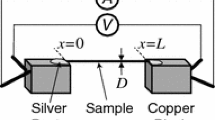The carbon-composite under investigation consists of a felt of carbon fibers infiltrated by a nanoporous sol-gel derived carbon aerogel; in addition, cracks caused by the shrinkage of the gel upon drying are present within the composite. Due to the anisotropic structure of the felt, consisting of a pinned stack of fiber mats, the thermal conductivity of the compound is anisotropic. The components of the thermal conductivity in the different directions were measured at room temperature using a non-contact technique, which was formerly established for fibers and foils. Here, a high-power laser diode is used for non-contact heating and a thermographic system for non-contact detection of the surface temperature of the samples. The stationary profile of the surface temperature next to the laser focus was evaluated with respect to the lateral thermal conductivity. Using a line-shaped laser focus, a one-dimensional heat flow within the samples was established and the two relevant components of the thermal conductivity in the different directions could be separated by investigating slices of the composite with different orientation to the main fiber orientation of the felt. The anisotropy of the thermal conductivity, i.e., the ratio of the components perpendicular and parallel to the felt surface, was determined to be about two under vacuum conditions. This relatively small thermal anisotropy was in qualitative agreement with preliminary tests of the electrical conductivity. In addition, local inhomogeneities due to macroscopic voids within the samples influenced the observed temperature profile. As alternative measurement variants, point-shaped laser-heating of sample discs was used and evaluated in terms of a two-dimensional heat flow and periodic, i.e., dynamical heating of the sample slices with a line-shaped laser focus was used. The reliability of the results was also tested by comparing them to data derived with a guarded-hot-plate measurement of a (1.1 × 15 × 15) cm3 large tile.
Similar content being viewed by others
References
R. W. Pekala and F. M. Kong, Proc. 2nd Int. Symp. on Aerogels (Montpellier, France, 1989), C4-34, C4-35.
J. Fricke and R. Petricevic, Carbon Aerogels, Handbook of Porous Solids, F. Schüth, K. Sing, and J. Weitkamp, eds. (Wiley-VCH, Weinheim, 2002), Vol. 3, pp. 2037–2062.
Fricke J. (1993) . High. Temp.-High Press. 25:379
Parker W.J., Jenkins J.R., Butler P.C., Abbott G.I. (1961) . J. Appl. Phys. 32:1679
Preston S.O. (1995) . High. Temp.-High Press. 27/28:111
Krapez J.-C., Spagnolo L., M. Frieß, Maier H.-P., Neuer G. (2004) . Int. J. Therm. Sci. 43:967
Kalogiannakis G., Hemelriejck D.V., Longuemart S., Ravi J., Okasha A., Glorieux C. (2006) . J. Appl. Phys. 100:063521
Rantala J. (1992) . Rev. Sci. Instrum. 63:5472
V. Drach, H. P. Ebert, and J. Fricke, Proc. 3rd Eur. Therm. Sci. Conf. 2000, E. W. P. Hahne, W. Heidemann, and K. Spindler, eds. (Edizioni ETS, Pisa, 2000), Vol. 2, pp. 637–643.
Drach V., Ebert H.P., Fricke J. (2000) . High. Temp.-High Press 32:337
R. Breiter, W. Cabanski, R. Koch, K.-H. Mauk, W. Rode, J. Ziegler, K. Eberhardt, R. Oelmaier, M. Walther, and H. Schneider, Proc. Int. Conf. Infrared Sensors and Systems (IRS 2 2000) (AMA Services, Wunsdorf, 2000), pp. 25–32.
V. Drach, G. Harhausen, H. P. Ebert, and J. Fricke, Proc. Int. Conf. Infrared Sensors and Systems (IRS 2 2002) (AMA Services, Wunsdorf, 2002), pp. 191–196.
Wolf A., Pohl P., Brendel R. (2004) . J. Appl. Phys. 96:6306
H. S. Carslaw and J. C. Jaeger, Conduction of Heat in Solids (Clarendon Press, Oxford, 1959), Section. 4.6, p. 142.
H. S. Carslaw and J. C. Jaeger, Conduction of Heat in Solids (Clarendon Press, Oxford, 1959), Section. 4.6, p.143.
HEAT2 Version 4.0, http://www.blocon.se, http://www.buildingphysics.com
H. Altmann, Bestimmung der Temperaturleitfähigkeit dünner Schichten mit dem Angström-Verfahren, Ph. D. Thesis, University of Würzburg (1997).
H. S. Carslaw and J. C. Jaeger, Conduction of Heat in Solids (Clarendon Press, Oxford, 1959), p. 66.
Y. S. Touloukian, R. W. Powell, C. Y. Ho, and P. G. Klemens, Thermophysical Properties of Matter, Vol. 5, Specific Heat Capacity, Nonmetallic Solids (IFI/Plenum, New York, 1979), p. 9.
DIN EN 12667, Deutsches lustitut fur Normung e.v., Thermal performance of building materials and products—Determination of thermal resistance by means of guarded not plate and heat flow meter methods—products of high and medium thermal resistance; German version EN 12667:2001 (Beuth, Berlin).
Author information
Authors and Affiliations
Corresponding author
Rights and permissions
About this article
Cite this article
Drach, V., Wiener, M., Reichenauer, G. et al. Determination of the Anisotropic Thermal Conductivity of a Carbon Aerogel–Fiber Composite by a Non-contact Thermographic Technique. Int J Thermophys 28, 1542–1562 (2007). https://doi.org/10.1007/s10765-006-0145-z
Published:
Issue Date:
DOI: https://doi.org/10.1007/s10765-006-0145-z




